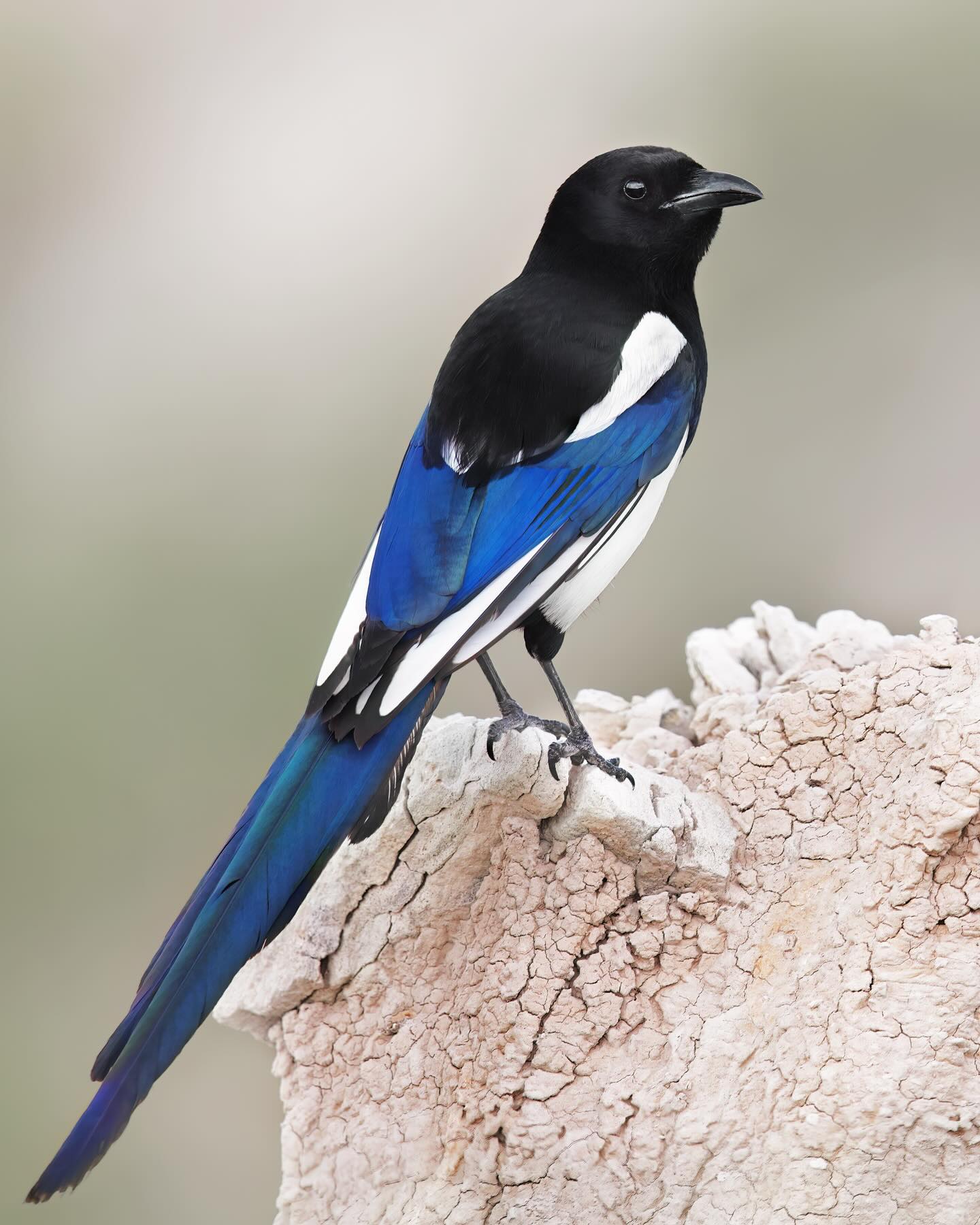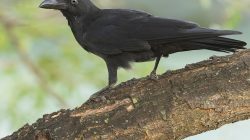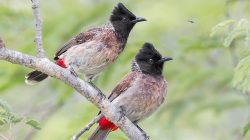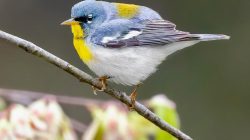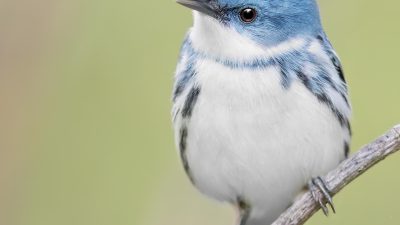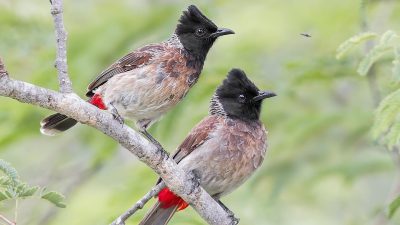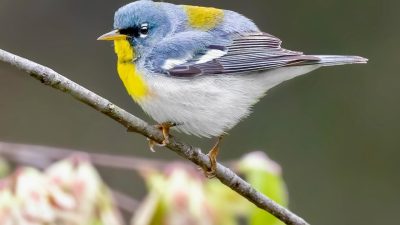Black-billed Magpie (Pica hudsonia)
Diajar.net – The Black-billed Magpie (Pica hudsonia) is a strikingly beautiful and highly intelligent bird, belonging to the crow family (Corvidae). With its vivid plumage, distinct black bill, and remarkable social behavior, this bird has captured the interest of ornithologists, birdwatchers, and nature enthusiasts alike. In this comprehensive article, we will explore various facets of the Black-billed Magpie, delving into its origin, physical appearance, distribution, geographical range, habits, diet, population numbers, and conservation status.
Origin of Animal Name
The Black-billed Magpie’s scientific name, Pica hudsonia, is derived from its genus Pica and its species name hudsonia. The genus name “Pica” is believed to be derived from the Latin word for magpie, which also refers to a variety of birds that belong to the Corvidae family. This is a typical naming convention for birds that exhibit the typical magpie characteristics, such as long tails, striking coloration, and a reputation for intelligence.
The species name “hudsonia” is linked to the bird’s association with the Hudson Bay region, which is part of its native range in North America. The first documented specimens of the Black-billed Magpie were collected in this area during the 18th century, which is why it was named after the Hudson Bay region. The bird’s common name, “Black-billed Magpie,” directly references its defining physical characteristic: the black-colored bill.
Appearance
The Black-billed Magpie is a striking bird that is easily recognizable due to its bold, contrasting plumage. Its most prominent feature is its long, iridescent tail, which is one of the longest in proportion to body size in the avian world. The bird’s overall body length is approximately 45 to 60 cm (18 to 24 inches), with the tail making up over half of its total length.
The plumage is a beautiful combination of black and white. The bird’s head, wings, and tail are primarily black with a glossy, iridescent sheen, which can appear green, blue, or purple, depending on the angle of the light. The wings have a white patch near the shoulder, and the bird’s belly and underparts are predominantly white. The legs and bill are black, adding to the striking contrast in coloration.
One of the key features that distinguishes the Black-billed Magpie from other magpies, such as the Eurasian Magpie (Pica pica), is its black bill, which contrasts with the lighter-colored bills found in other species. The bill is slightly curved, sharp, and well-suited for the bird’s omnivorous diet.
In terms of sexual dimorphism, the male and female Black-billed Magpies appear nearly identical. There is no significant difference in size or coloration between the sexes, which is common in many bird species where the female may not require distinctive markings for mating purposes.
Distribution
The Black-billed Magpie has a fairly extensive range across North America, particularly in the western regions. The bird is most commonly found in Canada, the northern United States, and parts of the northern Rocky Mountains, the Great Basin, and the plains. This species prefers open landscapes, such as grasslands, agricultural fields, and riparian zones with scattered trees or shrubs.
Historically, the Black-billed Magpie has been more concentrated in areas near the Hudson Bay, but over time, its range has expanded southward and westward. It is now found as far south as the northern parts of Mexico, although its population density is significantly higher in the more temperate regions of Canada and the northern United States.
The Black-billed Magpie’s range overlaps with that of the Eurasian Magpie (Pica pica) in some parts of North America, though the Black-billed Magpie is more prevalent in open habitats, while the Eurasian species is often found in more urbanized environments.
Geography
The geographical distribution of the Black-billed Magpie is closely tied to the environmental characteristics of North America. The bird’s range spans the boreal forests and expansive grasslands of Canada and the northern United States, with a preference for regions that offer both open spaces and trees. It is especially abundant in places with riparian vegetation, which provides ample food sources and suitable nesting locations.
The bird’s range extends along the western Great Plains, where it can be seen foraging in agricultural lands and near water sources such as rivers, lakes, and wetlands. This species also thrives in the Rocky Mountains and other higher elevation areas, where the terrain is diverse and supports a wide variety of plant and animal life.
In areas where the Black-billed Magpie is found in large numbers, the bird can be a common sight, especially during the warmer months. As a highly adaptable species, the Black-billed Magpie has been able to take advantage of various ecological zones, from the lowland prairies to the forested foothills of the mountains.
Habits and Lifestyle
Black-billed Magpies are social birds known for their complex communication systems and sophisticated behaviors. These birds are often seen in pairs or small groups, especially during the breeding season. They are non-migratory, typically remaining in the same geographic area year-round, though some individuals may move to lower altitudes during the winter months to avoid harsh conditions.
Magpies are highly intelligent, exhibiting problem-solving skills, tool usage, and even the ability to recognize themselves in mirrors, which is a sign of self-awareness. They are known to be curious creatures, often exploring their environment and interacting with objects or other species. They have a reputation for stealing shiny objects, a characteristic shared with other magpies and corvids.
Black-billed Magpies are also territorial birds, particularly during the breeding season, when they fiercely protect their nests. These birds are monogamous and typically form long-lasting pair bonds. The male performs elaborate courtship displays, which may include vocalizations and the offering of food to the female.
When not engaged in breeding or territorial defense, Black-billed Magpies are often found foraging together in small groups. They are highly vocal, with a wide range of calls used for communication. These calls can serve various purposes, such as warning of predators, marking territory, or signaling to other members of their group.
Diet and Nutrition
The Black-billed Magpie is an omnivorous bird with a highly varied diet. It feeds on a wide range of foods, including insects, small mammals, seeds, fruits, and even carrion. During the warmer months, insects form a significant portion of their diet, with beetles, grasshoppers, and caterpillars being particularly important. In the winter months, when insects are less available, the bird relies more heavily on seeds, fruits, and any available food scraps.
In addition to its insect and plant-based diet, the Black-billed Magpie is known to scavenge, feeding on the carcasses of dead animals. They will often be seen around roadsides, where they can take advantage of roadkill. The bird’s ability to adapt its diet based on the availability of resources is one of the key reasons for its success in a wide range of environments.
The Black-billed Magpie is also known for its ability to store food, hiding caches of seeds and other edible items in trees and shrubs. This behavior ensures that the bird has access to food during leaner months when resources are scarce.
Population
The population of the Black-billed Magpie has fluctuated over the years, but it is generally considered to be stable. The species is not classified as endangered or threatened, and in some areas, its population is quite abundant. In parts of North America, particularly in the western United States and Canada, the Black-billed Magpie is a common bird, and its presence in urban and rural areas alike makes it a familiar sight.
The overall population of the Black-billed Magpie is estimated to be in the millions, with the bird being relatively widespread across its range. However, like many species, the bird faces challenges due to habitat loss and environmental changes. Human activities such as urbanization, agriculture, and deforestation can impact the bird’s population by reducing the availability of suitable nesting and foraging habitats.
Number of Populations
The number of populations of the Black-billed Magpie is difficult to quantify precisely, but the species is known to have several distinct populations spread across its range. These populations are often separated by geographical features such as mountain ranges or large bodies of water. While some populations are more concentrated in particular regions, such as the Great Plains or the Rocky Mountains, the bird is generally distributed across large areas of suitable habitat.
Researchers continue to study the distribution and dynamics of Black-billed Magpie populations, and efforts are being made to monitor the health of these populations through long-term ecological studies. These studies help scientists understand the impacts of climate change, habitat destruction, and other environmental factors on the bird’s overall numbers.
Conservation
The Black-billed Magpie is currently not considered a species of conservation concern. Its population is stable and it is listed as a species of “Least Concern” by the International Union for Conservation of Nature (IUCN). However, like many birds, the Black-billed Magpie is not immune to the threats posed by human activities.
Habitat destruction, particularly the draining of wetlands and the expansion of urban areas, can reduce the availability of suitable nesting and foraging habitats for the bird. Additionally, changes in land use, such as the conversion of grasslands into agricultural fields, can alter the bird’s natural food sources and migration patterns.
In some regions, the Black-billed Magpie has been persecuted due to its reputation as a nest predator, particularly in areas where farmers raise ground-nesting birds like pheasants. However, there is no widespread evidence to suggest that these activities are threatening the overall population of the species.
Conservation efforts for the Black-billed Magpie focus on preserving its natural habitats, maintaining healthy ecosystems, and ensuring that the species continues to thrive in a changing world. These efforts include habitat restoration programs, the creation of protected areas, and continued monitoring of the bird’s populations to ensure that they remain stable.
Conclusion
The Black-billed Magpie (Pica hudsonia) is a fascinating and resilient bird that plays an important role in the ecosystems of North America. With its distinctive appearance, intelligence, and adaptability, the Black-billed Magpie continues to capture the attention of birdwatchers and researchers alike. While its population remains stable for now, it is essential to continue monitoring the species to ensure that its habitats are preserved and that it remains a thriving part of the natural world for generations to come.
